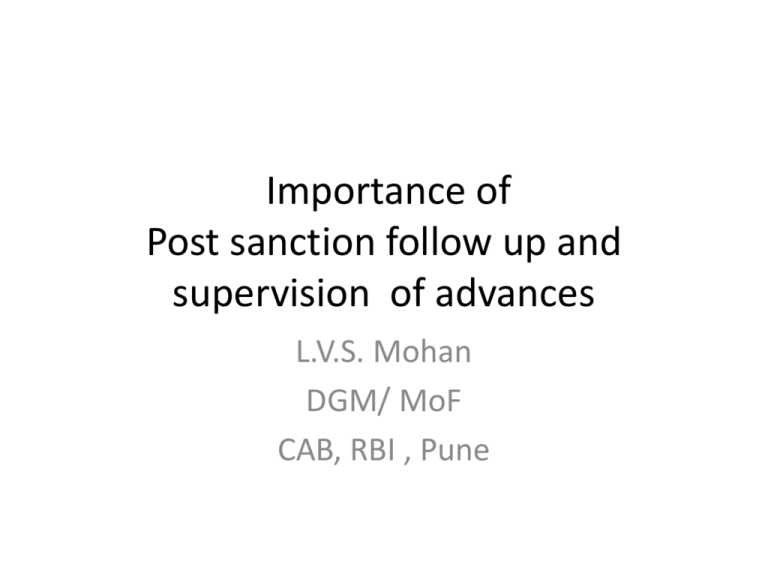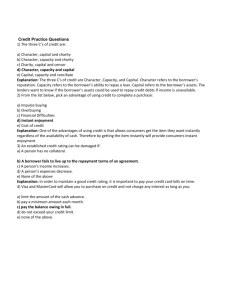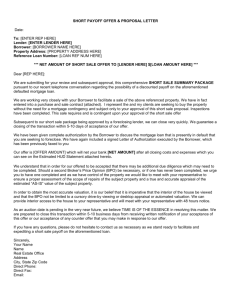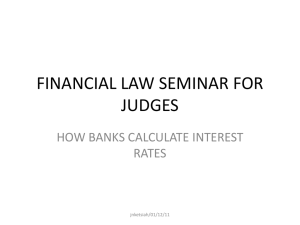Importance of Post sanction follow up and supervision of
advertisement

Importance of Post sanction follow up and supervision of advances L.V.S. Mohan DGM/ MoF CAB, RBI , Pune Pre- sanction appraisal • It is concerned with measurement of risk of a loan proposal. • Requirements: Financial data of past and projected working results Detailed credit report is compiled on the borrower/surety Market reports, Financial/ audited accounts Income tax and other tax returns/assessments Confidential reports from banks and other FIs Appraisal should reveal whether the proposal is a fair banking risk. Post sanction appraisal • Depends to a large extent on the pre sanction appraisal • Requirements: Documentation of the facility and after care follow up Supervision thro monitoring of transactions in loan account Scrutiny of periodical statements submitted by borrower Physical inspection of securities and books of accounts of the borrower Periodical reviews and renewals Need for post sanction supervision • Lending decisions are based on sound appraisal and assessment of credit worthiness • Past record of satisfactory performance and integrity are no guarantee for future though they serve as a useful guide to project the trend in performance, • Credit assessment is made based on promises and projections • A loan granted on the basis of sound appraisal may go bad because the borrower did not carry out his promises regarding performance. Objectives of post sanction supervision • To ensure compliance with the terms and conditions of sanction • To ensure that the assumptions on the basis of which the credit decisions were made were correct. • To ensure end use of funds • To ensure adequacy of credit on an ongoing basis depending upon the actual requirement of the borrower Objectives of post sanction supervision • To monitor health of the unit and detect signals of weaknesses in the financial position of the borrower. • The process of the supervision and follow up starts immediately after the limit is sanctioned. Indicative activities of post sanction follow up • Conveying sanction of advances to the borrower detailing the terms and conditions and acceptance thereof. • Completion of appropriate documentation before disbursement of loans/ advances • Keeping the documents in effective custody and maintaining validity by periodic revival of documents during the currency of loans • Creation of charge over security and completion of relevant formalities creation of charge Registration with ROC Indicative list of activities • Periodic search of charge with the authority should be done to protect the bank’s interest • Ensuring compliance by borrower of all pre-disbursal activities and requirements and continued compliance with the terms till the loan is liquidated • Conducting periodic inspections/visits at stipulated intervals • Obtaining from the borrowers and scrutiny /analysis of the following financial statements and non financial statements Stock statements Annual and mid term financial statements Indicative activities • Ongoing scrutiny of transactions in various accounts by perusal of ledgers, registers, vouchers, to watch proper conduct of loan accounts, healthy turnover therein and end use of funds • Maintaining ongoing contact with the borrower and co-lenders • Timely recognition of unsatisfactory features in the conduct of advance such as: delays in project implementation Unusual developments / changes in the business environs Shortfall in achievement of production/sales as compared to projections Non-fulfilment of financial obligations to the bank, co-lenders, and creditors and non payment of statutory dues. Any other deficiency noted during the periodic visit Indicative activities • Advising the borrowers to initiate the corrective action and submitting reports to the controlling authority on further developments in the matter • Follow up of and rectification of irregularities pointed out in various inspection / audit reports including RBI Inspection report Central office inspection report Concurrent audit report Statutory audit report Recovery of applicable charges/fees/penalties Preparation of review of IRAC identification of deteriorating assets/potential NPAs and initiation of corrective action Documentation - Need • Evidence of bank having given money/ advance • Receipt of borrower having received money/facility • Details the terms and conditions on which the money/facility are sanctioned • Purpose for which the money /facility was sanctioned Documentation - NEED • • • • • Defines security Creates charge on the security Defines default clauses Decides and facilitates legal action Specifies the rights and obligations of each of the parties Properly executed document • • • • Fully completed without blanks Signed Stamped Registered , if required Supervision • Ensure proper follow up of advances and observance of systems laid down by the bank at the operating level. • Periodic and random examination of registers, accounts and books at the branch • Ensuring that the security documents are kept current and that officials observe all related documentation facilities • Ensuring that (i) proper arrangements are in place for recovery of applicable charges /fees/ penalties and income leakage is checked Supervision (contd) • Maintaining ongoing contact with borrowers and co-lenders and keeping abreast of developments in borrowers entities and business environment. • Scrutiny of periodic statements received from the borrowers and control statements/ reports statements prepared on the advances • Periodic inspection of security at the intervals prescribed for the supervisor. • Conduct periodic assessment of the information thrown up by IRAC reviews and ensure identification of deteriorating assets and initiation of corrective steps. • Exercise control over NPA management and ensure effective follow up for recoveries/ rehabilitation with the approval of appropriate authorities Supervision (contd) • Ensure timely reviews / renewals of credit facilities Monitoring • Ensuring that effective supervision is maintained on loans/ advances by the lower level functionaries. Scrutiny of returns / reports received from these line functionaries, interaction with them feed back from customers , observations in audit / inspection reports will assist this process. • Monitoring of high value advances through specific focus on these in returns / reports received • Ensuring non recurrence of commonly noticed lapses /irregularities pointed out in various reports • Examination of NPAs with a view to recognizing problem assets, drawing up recovery/ upgradation path for these and monitoring recovery process RETAIL LOANS Advances against motor vehicles: • Advances should be confined to new vehicles • The bank should insist on production of original invoice from the borrower • The borrower should execute a deed hypothecating the vehicle in favour of the bank. • The bank’s lien should be got recorded with the RTO as well as the book before the loan is disbursed, • The vehicle should be comprehensively insured and the policy should be assigned in favour of the bank. • The vehicles should be inspected periodically to ensure that it is in a road worthy condition and it is in the possession of the borrower Advances against vehicles • • • • • • Documentation: Demand/time promissory note Hypothecation deed Registration certificate with bank’s lien Insurance policy with bank clause Blank transfer form duly signed by the borrower(in the event of default the bank has power to seize the vehicle and arrange for its sale. Advances against life insurance policies • Advantages It is not subject to fluctuations in market value The loan needs very little supervision and expense Its value steadily increases the longer it is held the higher will be its value. The bank should obtain a declaration from the borrower that the policy is free of charge and that no charge is created as long he is indebted to the bank Life insurance policies The bank to obtain a letter of authority from the borrower to pay the premia by debit to his loan account if not paid by the borrower before due date. An absolute assignment in favour of the bank duly witnessed should be obtained in the prescribed form. The assignment shall be normally made on the policy itself. The insurance policy should be sent to the insurance companies for registration of the policy Housing loans • • • • • Phase of construction Architect certificate Inspection of the house Completion certificate Insurance of property Early Warning Signals Early Warning Signals (EWS) • EWS can be classified into five (5) broad categories • Financial warning signals • Operating warning signals • Management related warning signals • Bank related signals • Signals relating to external factors Financial warning signals • • • • Persistent irregularity in the account Default in repayment obligation Devolvement of LC /invocation of guarantees Deterioration in the liquidity or working capital position • Substantial increase in long term debts in relation to equity • Declining sales Financial warning signals(contd) • Operating losses/net losses • Rising sales and falling profits • Disproportionate increase in overheads in relation to sales • Rising level of bad debt losses Operating warning signals • Low activity level in the plant • Disorderly diversification / frequent changes in plan • Non payment of wages/power bills • Loss of critical customers • evidence of large level of inventory/ aged inventory Management related warning signals • Lack of cooperation from key personnel • Change in management, ownership or key personnel • Desire to take undue risks • Family disputes • Diversion of funds • Fudging of ACCOUNTS Banking related signals • Declining bank balances/ declining operations in the account • Opening of accounts with other banks • Return of outward bills/ dishonoured cheques • Frequent requests for loan • Sales transactions not routed through the account • Frequent delays in submitting stock statements, financial data etc Signals relating to external factors • • • • • Economic recession Emergence of new competition Emergence of new technology Changes in government/ regulatory policies Natural calamities. Important guidelines of RBI on monitoring operations in loan accounts • Annual review of advances Imperative for the banks to undertake an exercise for review of the advances on a regular basis. Review should specifically attempt to make an assessment of the working capital requirements of the borrower based on the latest data available whether the limits continue to be within the need based requirements and according to the bank’s prescribed lending norms. Diversion of funds • Diversion of funds would be construed to include any one of the under noted occurrences: utilization of short term working capital funds for long-term purposes not in conformity with terms of sanction Deploying borrowed funds for purposes /activities or creation of assets other than those for which the loan was sanctioned Transferring funds to the subsidiaries / group companies by whatever modalities Diversion of funds (contd) Routing of funds through any bank other than the lender bank or members of consortium without prior permission of the lender Investment in other companies by way of acquiring equities / debt instruments without approval of lenders Shortfall in deployment of funds vis- a- vis the amounts disbursed / drawn and the difference not being accounted for. Diversion of funds (contd) • Whenever diversion of funds is noticed UCBs should take appropriate action including recalling the loans, reduction of sanctioned limits, charging the penal interest etc to protect the bank’s interest. • Whenever stocks under hypothecation to cash credit and other loan accounts are found to have been sold but the proceeds have not been credited to the loan account such action should be treated as fraud . • In such cases bank may take immediate steps to secure the remaining stock so as to prevent further erosion in the value of available security as also other steps as warranted Siphoning of funds • Funds borrowed are utilised for purposes unrelated to operations of the borrower • Such actions are detrimental to the interests of the lender • Banks to decide whether the acts relate to siphoning of funds End use of funds • Monitoring and ensuring end use of funds Meaningful scrutiny of quarterly progress reports/operating statements/balance sheets of borrowers Regular inspection of borrowers assets charged to the lenders as security Periodical scrutiny of borrowers books of accounts and the no lien accounts maintained with other banks End use of funds (contd) • Periodical visits to the assisted units • System of periodical stock audit in case of working capital finance In cases of project financing banks should seek end use of funds by obtaining certification from CA. In case of short term corporate /clean loans bank should themselves undertake due diligence. Exchange of Credit Information • The Credit Information Companies (Regulation) Act, 2005 has been operationalised wef December 14, 2006. • In terms of sec 15 (1) of the Act every credit institution has to become a member of atleast one credit information company. • As UCBs fall under the category of credit institution they are required to take membership of atleast one credit information company and provide credit data (positive as well as negative) to the credit information company. Exchange of credit information • Credit information companies Credit Information Bureau (India) Limited (CIBIL) M/s Experian Credit Information company of India Pvt Ltd Equifax Credit Information services Pvt Ltd High Mark Credit Information Services Pvt Ltd Banks should incorporate suitable clauses in the loan agreements regarding exchange of credit information so as to address issues of confidentiality Exchange of information – lending under consortium arrangement /multiple banking arrangements • At the time of sanctioning fresh advances banks may obtain declaration from borrowers about credit facilities enjoyed by them from other banks. • Banks should exchange information about conduct of the borrower’s accounts on quarterly basis • Make use of credit reports available from credit information companies • Banks to introduce suitable clauses to address confidentiality issue Wilful default • A wilful default is deemed to have occurred if any of the following events is noted: The unit has defaulted in meeting its payment /repayment obligations to the lender even when it has the capacity to honour the said obligation The unit has defaulted in meeting its payment/repayment obligations to the lender and has not utilised the finance from the lender for the specific purposes for which the finance was availed but has diverted the funds for other uses Wilful default The unit has defaulted in meeting its payment/ repayment obligations to the lender and has removed or disposed of the movable fixed assets or immovable property given by it for the purpose of securing term loan without the knowledge of the bank/ lender Disclosure of information and monitoring of defaulting borrowers • Scheduled UCBs are required to submit to the RBI as at the end of September and March every year the details of borrowal accounts which have been classified as doubtful, loss, suit filed with outstanding (both under funded and non funded limits) aggregating Rs 1 crore and above • RBI is circulating to the banks and financial institutions the information on defaulters . • The banks and financial institutions may make use of information while considering requests for new or additional limits by existing and new constituents Disclosure of information (contd) • The data on borrowal accounts against which suits have been filed for recovery of advances (outstanding aggregating Rs 1.00 crore and above) and suit filed accounts of wilful defaulters with outstanding balance of Rs 25.00 lakh and above based on information furnished by SCBs and financial institutions is available at www. cibil.com. • UCBs can verify the lists to ensure that the defaulting borrowing units as also their proprietors/partners/directors etc named in the list of suit- filed accounts either in their own names or in the names of other units are not extended further credit facilities. Penal measures for defaulters • In order to prevent access to the capital markets by the wilful defaulters a copy of the list of wilful defaulters is forwarded by RBI to SEBI as well. • Penal measures : No additional facilities to be granted to listed wilful defaulters. In addition the entrepreneurs/ promoters of companies where banks have identified siphoning /diversion of funds etc should be debarred from institutional finance for floating new ventures for a period of five years from the date the name of wilful defaulter is published in the list published by RBI Penal measures The legal process where warranted against borrowers /guarantors and foreclosure of loans should be initiated expeditiously. Criminal proceedings may be initiated against wilful defaulters Banks should also adopt proactive approach for a change in management of the wilfully defaulting unit. Filing of suits to recover from willful defaulters • Scheduled UCBs to examine all cases of default of Rs 1.00 crore and above and file suits in such cases. • In case of willful faults if there are instances of cheating/fraud by the defaulting borrowers criminal cases should be filed in such cases. • In case of amounts below Rs 1 crore banks should appropriate action including legal action. Role of auditors • Incase of falsification of accounts on the part of lenders , if it is observed that CA was negligent or deficient in conducting the audit matter may be reported to the ICAI to examine and fix accountability of the auditors • If the lenders desire a specific certification from auditors regarding diversion/siphoning of funds lenders should award a separate mandate for the purpose.







